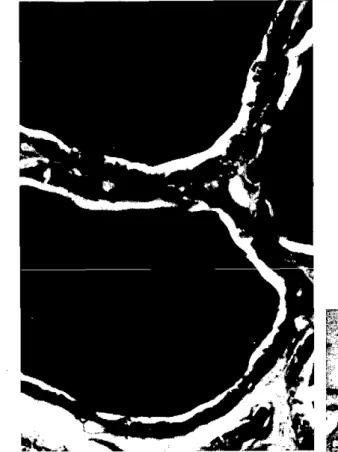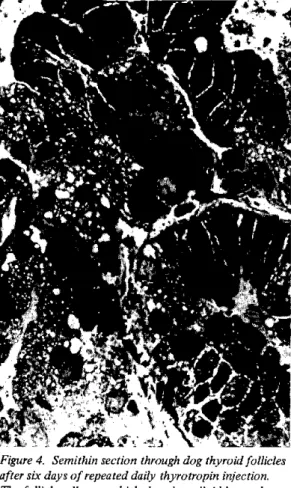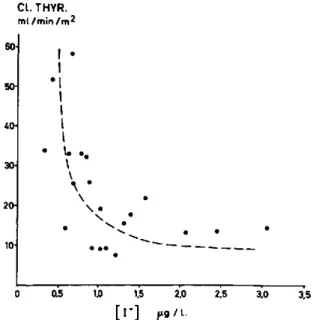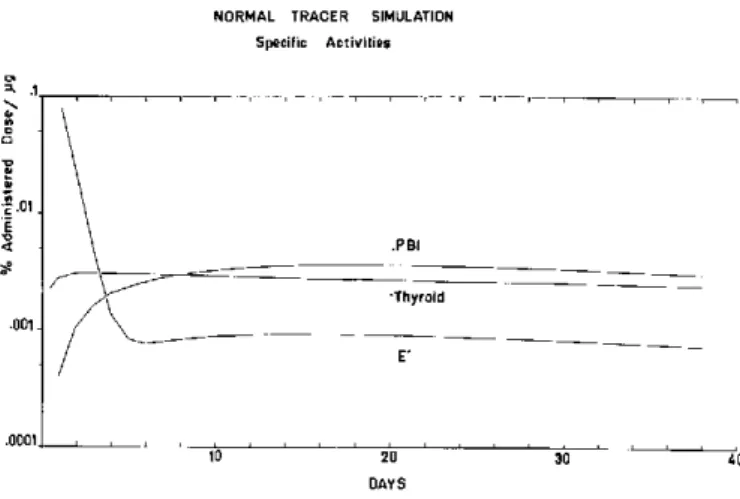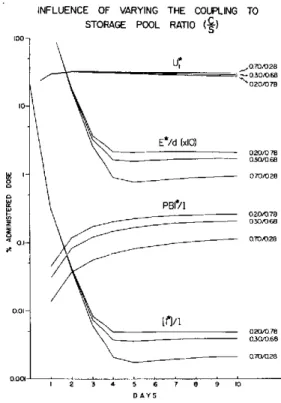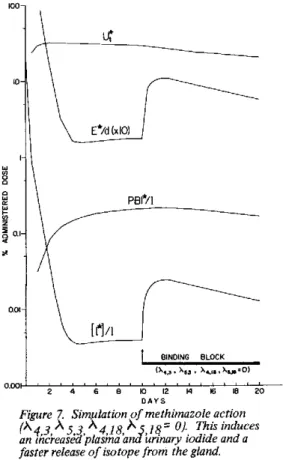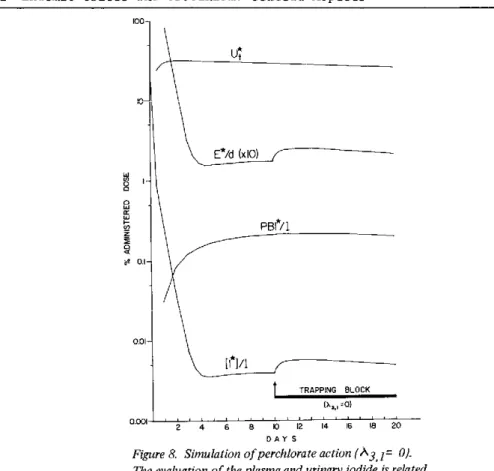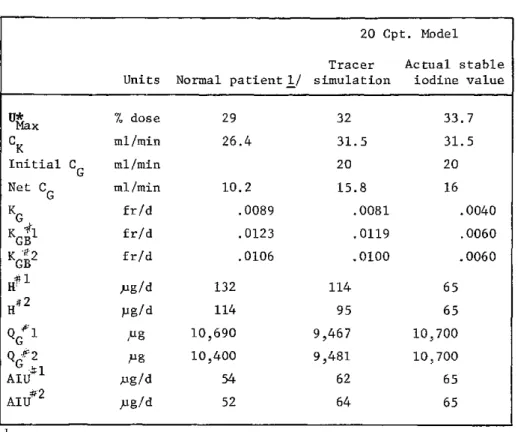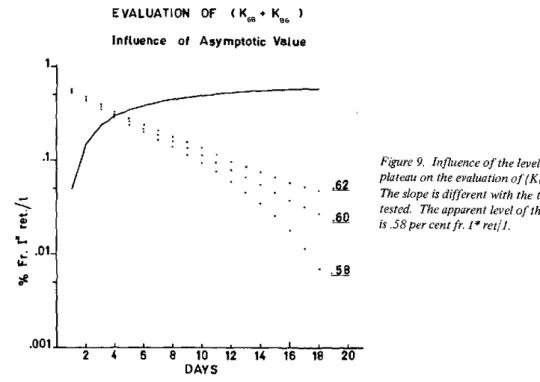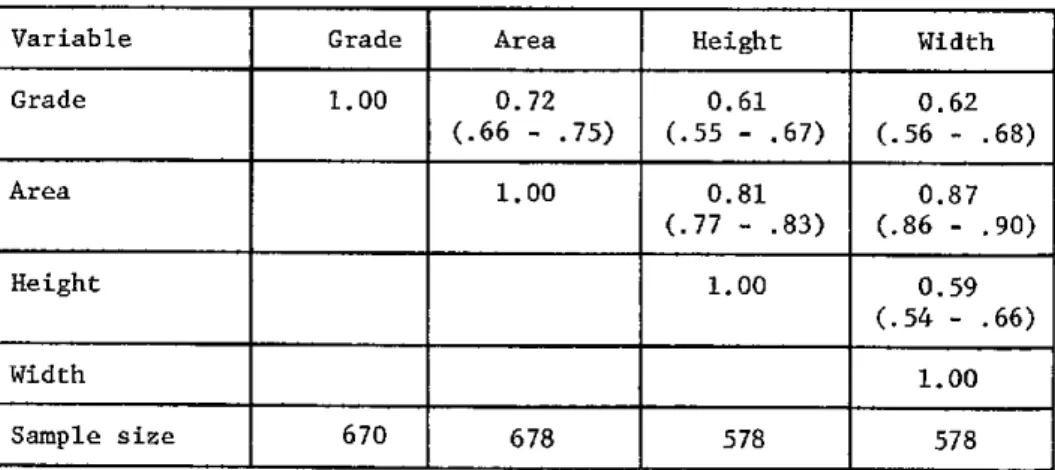ENDEMIC
GOlTER
Report of the Meeting of the PAHO Scientific
Group on Research in Endemic Goiter held
in Puebla, Mexico, 27 to 29 June 1968
COMPILED AND EDITED BY
JOHN B. STANBURY, M.D.
PAN AMERICAN HEALTH ORGANIZATION Pan American Sanitary Bureau, Regional Office of the
WORLD HEALTH ORGANIZATION
ENDEMIC GOITER
Report of the Meeting of the PAHO Scientific
Group on Research in Endemic Goiter held
in Puebla, Mexico, 27 to 29 June 1968
Compiled and Edited by
JOHN B. STANBURY, M.D.
Professor of Experimental Medicine, Department of Nutrition and Food Science,
Massachusetts Institute of Technology; Lecturer, Harvard Medical School;
Board of Consultation, Massachusetts General Hospital
Scientific Publication No. 193
PAN AMERICAN HEALTH ORGANIZATION Pan American Sanitary Bureau, Regional Office of the
WORLD HEALTH ORGANIZATION 525 Twenty-Third Street, N.W.
CONTENTS
Page
Preface-J.
B. Stanbury ...
vii
Participants ...
xi
SECTION
I. Endemic Goiter and Cretinism: General Aspects
1. Intrathyroid Iodine Metabolism in
Goiter-A. M. Ermans ...
1
2. Recent Advances in the Knowledge of the Control of Thyroid
Growth and Function-J.
E. Dumont, P. Neve, and J. Otten ...
14
3. Pathophysiology of Nontoxic Goiter-C.
Beckers ...
30
4. A Thyroid Model and its Analysis by Computer-P.
L. Decostre, R. D.
Phair, I. W. Dingwell, and L. J. DeGroot ...
49
5. Observer Variation in Grading and Measuring the Thyroid in
Epidemi-ological Surveys-R.
MacLennan, E. Gaitán, and M. C. Miller ...
67
6. Prevention of Endemic Goiter in Latin America-J.
P. Kevany ...
78
7. Endemic Cretinism: A Search for a Tenable Definition-A.
Querido ..
85
8. Endemic Cretinism-J.
E. Dumont, F. Delange, and A. M Ermans ...
91
SECTION II. Endemic Goiter in the Congo and New Guinea
9. Permissive Nature of Iodine Deficiency in the Development of
Endemic Goiter-A.
M. Ermnans, C. Thilly, H. L. Vis, and F. Delange .
101
10. Treatment of Idjwi Island Endemic Goiter by Iodized
Oil-F. Delange,
C. Thilly, P. Pourbaix, and A. M. Ermnans ...
118
11. Endemic Goiter in New Guinea and the Prophylactic Program with
Iodinated Poppyseed Oil-I.
H. Buttfield and B. S. Hetzel ...
132
SECTION III. Endemic Goiter in Argentina and Paraguay
12. Characteristics of Endemic Goiter in a Mapuche Indian Tribe in
Chiquillihuin, El Malleo, Province of Neuquen, Argentine Republic: I.
General Aspects and Some Functional and Genetic Studies-O. J.
Degrossi, N. Altschuler, H. Forcher, A. A. Zaninovich, O. M.
Mutchinick, and C. L. Enriori ...
149
13. Characteristics of Endemic Goiter in a Mapuche Indian Tribe in
Chiquillihuin, El Malleo, Province of Neuquen, Argentine Republic:
II. Iodine Kinetic Studies-O:
J. Degrossi, T. Watanabe, N. Altschuler,
V. Pecorini, and C. Santillán ...
159
14. Endemic Goiter in the Republic of Paraguay-N.
Altschuler, O. J.
Degrossi, R. Ceriani, H. Forcher, V. Mayor, and C. L. Enriori
...
168
CONTENTS (cont.)
SECTION IV. Endemic Goiter in Brazil
15. Endemic Goiter in Brazil-G.
A. Medeiros-Neto, L. C. G. Lobo, and W.
Nicolau ...
179
16. Studies on the Concentration of Particulate Iodoprotein, RNA, and
DNA in Normal and Endemic Goiter Glands-G.
A. Medeiros-Neto, W.
Nicolau, and A. B. Ulhoa Cintra ...
183
17. Studies on Endemic Goiter and Cretinism in Brazil: 1.
Epidemiologi-cal Survey in Mato Grosso-L.
C. G. Lobo, A. Quelce-Salgado,and A.
Freire-Maia
...
194
18. Studies on Endemic Goiter and Cretinism in Brazil: 2. Genetic
Studies-L.
C. G. Lobo, A. Quelce-Salgado, and A. Freire-Maia
...
208
19. Studies on Endemic Goiter and Cretinism in Brazil: 3. Thyroid
Function
Studiecs-D. Dosen+hal, L.
C. G.
Lob, M A.
A.
ello,
uan
J.
Fridman ...
217
SECTION V. Endemic Goiter in Chile
20. Endemic Goiter in Chile-J.
Barzelatto ...
229
21. Study of Endemic Goiter in the American Indians-J.
Barzelatto and
E. Covarrubias ...
233
22. Endemic Goiter in Pedregoso (Chile): Experimental Goitrogenic
Activity of "Piñón"-M.
Tellez, A. Gianetti, E. Covarrubias, and J.
Barzelatto ...
245
23. Genetic Questions Related to the Goiter Endemia of Pedregoso
(Chile)-E.
Covarrubias, J. Barzelatto, and R. Guiloff ...
252
SECTION VI. Endemic Goiter in Colombia
24. Studies on the Pathogenesis of Endemic Goiter in the Cauca Valley,
Colombia-E.
Gaitán and H. W. Wahner ...
267
25. Thyroid Function in Adolescents from the Goiter Endemic of the
Cauca Valley, Colombia-H.
W. Wahner and E. Gaitán
...
291
SECTION VII. Endemic Goiter in Ecuador
26. Iodized Oil in the Prevention of Endemic Goiter and Associated
Defects in the Andean Region of Ecuador: I. Program Design, Effects
on Goiter Prevalence, Thyroid Function, and Iodine Excretion-R.
Fierro-Benítez, I. Ramirez, E. Estrella, C. Jaramillo, C Díaz, and J.
Urresta ...
306
27. Iodized Oil in the Prevention of Endemic Goiter and Associated
Defects in the Andean Region of Ecuador: II. Effects on Neuro-Motor
Development and Somatic Growth in Children before Two Years-L.
Ramirez, R. Fierro-Benítez, E. Estrella, C. Jaramillo, C. Díaz, and J.
Urresta ...
341
CONTENTS (cont.)
28. Iodine Therapy for Endemic Goiter and Its Effect upon Skeletal
Development of the Child-H.
Israel, III, R. Fierro-Benítez, and J.
Garcés ...
360
29. Neurological Aspects of Endemic Cretinism-P.
R. Dodge, 1. Ramirez,
and R. Fierro-Benítez ...
373
30. Effect on Intelligence of Iodine in Oil Administered to Young Andean
Children: A Preliminary Report-P.
R. Dodge, H. Palkes, R.
Fierro-Benítez, and 1. Ramírez ...
378
3 1. Growth Hormone in Relation to Endemic Cretinism and
Dwarfism-M.
R. Harrison, R. Fierro-Benítez, 1. Ramirez, S. Refetoff,
and J. B. Stanbury ...
381
SECTION VIII. Endemic Goiter in Mexico
32. Endemic Goiter in Mexico and Its Changing Pattern in a Rural
Community-J.
A. Maisterrena, E. Tovar, and A. Chávez ...
397
33. Iodine Nutrition Levels of Schoolchildren in Rural Mexico-E.
Tovar,
J. A. Maisterrena, and A. Chávez ...
411
SECTION IX. Endemic Goiter in Peru
34. Endemic Goiter in Rural Peru: Effect of lodized Oil on Prevalence
and Size of Goiter and on Thyroid Iodine Metabolism in Known
Endemic Goitrous Populations-E.
A. Pretell, F. Moncloa, R. Salinas,
R. Guerra-García, A. Kawano, L. Gutiérrez, J. Pretell, and M. Wan ..
419
Index ...
441
PREFACE
Magnificent ceramic sculptures dating from pre-Colombian times are unassailable
witness to the existence of goiter in the western world before the European
settlement. Among the many figurines found in museums of archeology in the
Republics of Central and South America, those with goiter are rare. The prevalence
of goiter among the American Indians before Pizarro can only be conjectured. In
the years which followed the Conquest numerous travelers on both sides of the
spine of the Andes commented in their journals on the high frequency of the
disease among the indigenes. Did the degradation and improvishment of a great
people which certainly followed the arrival of the Spanish perturb some ecological
balance which necessitated growth of the thyroid? We would like to know.
The first demonstrations of the effectiveness of iodine in eliminating endemic
goiter were the trials of Marine and Kimball in Akron, Ohio, in 1917. The results
were startling and were soon confirmed in Switzerland and later in Guatemala,
where endemic goiter has now virtually vanished. No serious doubt remains
concerning the effectiveness of iodized salt in prophylaxis of goiter, and as a public
health measure salt iodization is economical, safe, and accepted. Irndeed many of
the governments of Latin America have taken heed and legislated iodization of salt,
but with few exceptions programs have not been implemented effectively, nor the
endemics reduced in scope. The reasons for these failures are in part economic, in
part political, and in part sociogeographic. Endemic goiter remains today a major
medical problem of rural Latin America, with an incidence and impact which is
probably as significant as it was a century or two ago, and even more important
because of the extraordinary rapid population growth of that part of the world.
In 1961, the Scientific Advisory Committee of the Pan American Health
Organization (PAHO), a panel of distinguished medical scientists from the Western
Hemisphere, set priorities for health research in Latin America. High on the list was
endemic goiter. It was abundantly evident that the challenge of endemic thyroid
disease warranted this degree of concern. It was also clear that much remained to be
learned about the thyroid in endemic goiter. It also seemed possible that
application of available research methods not only might yield some practical
dividends, but also might provide a nidus in various academic centers around which
research enterprise in medical science would crystallize.
The recommendations of the Advisory Committee were soon implemented by
selection of several investigators in universities of Central and South America who
were already experts in thyroidology and who worked in proximity to foci of
endemic goiter. Choice of necessity was arbitrary and limited in order that the
program could have a manageable size and realistic goals. The initial participants
were Dr. Jorge Maisterrena from the Institute of Nutritional Diseases in Mexico
City; Dr. Rodrigo Fierro from the University of Quito and the Technicologic
Institute of Quito, Ecuador; Dr. José Barzelatto of the Salvador Hospital and the
University of Chile; Dr. Yaro Gandra of the University of Sao Paulo, Brazil; Dr.
Luis Carlos Lobo then of the University of Rio de Janeiro and now Dean of the
Faculty of the University of Brasilia; and Drs. Marcel Roche and Karl Gaede of the
Venezuelan Institute of Scientific Research in Caracas. Each of these investigators
commanded a laboratory which was close enough to patients with endemic goiter
so that pathophysiological studies with contemporary techniques could be
conducted. Each enthusiastically agreed to participate in the PAHO program. Plans
were made, specific research programs suitable for each laboratory were identified,
and problems of logistics, personnel and financing were engaged.
The first meeting of the group was held from 22 to 26 April 1963 under the
sponsorship of PAHO at the Venezuelan Institute of Scientific Research in Caracas,
with Dr. Marcel Roche as host. In addition to the scientists from the participating
Latin American laboratories and their colleagues, several advisors from elsewhere
attended. Among these were Dr. Herbert Vetter of the International Atomic Energy
Agency, who had made many contributions to the application of radioisotopes to
the study of endemic goiter in Austria, and Professor'Andries Querido, then of the
University of Leiden, the Netherlands, and now of the University of Rotterdam. Dr.
Querido had just returned from a study of endemic goiter in the highlands of New
Guinea. Also attending as advisors were Drs. Andre Ermans and Jacques Dumont of
the Free University of Brussels and Dr. Christian Beckers of the University of
Louvain, who had had extensive experience in endemic goiter in the northern and
eastern zones of the Congo, and Dr. Robert Vought of the U.S. National Institutes
of Health, Bethesda, Maryland.
Much was accomplished at this meeting. The consultants described the disease as
thliey lihad seen it in varinous parts of the world. They dermonsntrated the kinds ofstudies which had proved profitable and which had clarified certain aspects of the
problem and had raised new questions begging for research. In turn the participants
from Latin America described the disease in their countries and the kinds of studies
which they had been able to accomplish. It emerged with great clarity from this
meeting that many aspects of endemic goiter remained for investigation and that
the resources both in patient material and scientific personnel of Latin America lent
themselves particularly well to further research both into the nature of the disease
and into alternative programs of prevention and treatment.
The Caracas meeting concluded with an assignment of research programs and
responsibilities to each of the Latin American participants. Dr. Maisterrena would
establish a two-bed metabolic unit in a field station in the village of Tepetlixpa, not
far from Mexico City. Dr. Fierro would continue his inventory of endemic goiter in
selected villages of rural Ecuador, would continue to gather detailed demographic
data from Tocachi and La Esperanza (villages 70 miles north of Quito), and would
do a thorough in-hospital study of a group of typical cretins. Dr. Barzelatto would
expand his genetic and physiological studies on the isolated goitrous Pewenche
Indians of Pedregoso in southern Chile. Dr. Gandra was to continue his
epidemiological studies among schoolchildren in the villages of Sáo Paulo State and
to begin studies on thyroid function and the effect of iodine prophylaxis under
controlled conditions. Dr. Lobo's plans included extensive genetic tabulations in
the Mato Grosso and in Goiás in central Brazil, combined with neurological
investigations on a group of cretins transported from these regions to Rio de
Janeiro. Drs. Roche and Gaede planned further observations on the thyroid
function of primitive isolated Indians of southern Venezuela.
A second PAHO meeting took place in Cuernavaca, Mexico, from 4 to 8 October
1965, with Dr. Maisterrena as host. By this time, Drs. Eduardo Pretell and Federico
Moncloa of the Cayetano Heredia Medical School in Peru had joined the program.
The group was priviledged to have as an additional consultant the late Dr. Richard
Follis. Reports were heard of research progress from each of the participating
laboratories, and plans were again made for future work. The meeting was
highlighted by the emergence of several unresolved problems. There was no
consensus on the precise definition or classification of endemic cretinism. This
remains to a degree unresolved, as may be seen in Chapters 7, 8, and 27 of this
volume. Various conummunications indicated the unresolved question of the
relationship between endemic goiter and cancer of the thyroid. Several papers
pointed out our lack of knowledge of the relationship of endemic goiter to certain
physical infirmities which appear in association with endemic goiter, such as
endemic deafmutism, short stature, and mental deficiency. The consensus was that
the time had come for pilot studies on the prevention of endemic goiter by means
of injection of iodized oil. This technique had been used successfully in New
Guinea. The reason for considering its use in Latin America was the failure of
iodized salt programs either to be implemented or because in many areas they were
impractical because of the economics of salt distribution in isolated and
impoverished communities. Plans were made for pilot projects in Ecuador and Peru,
and these began in Ecuador in March of 1966 and in Peru in October of the same
year.
The present volume comprises the papers presented at the third meeting of the
PAHO Study Group on Endemic Goiter. This meeting was held from 27 to 29 June
1968 in Puebla, Mexico. Dr. Maisterrena was again the host. By this time
investigators from Argentina had become participants in the program and Dr.
Geraldo Medeiros-Neto of Sao Paulo had also joined. An additional consultant was
Dr. Ian Buttfield of the University of Adelaide, Australia, Dr. Buttfield had had
much experience with iodized oil in New Guinea and with iodine prophylaxis in
Tasmania. Interest centered particularly on the results of the iodized oil
prophylaxis programs in Ecuador and Peru (see Chapters 26 and 34). These results
were compared with those obtained in New Guinea (Chapter 11) and in the Idjwi
Island of the Kivu Lake in the eastern Congo (Chapter 10). As a result of these
findings the consensus was that prophylaxis of endemic goiter with iodized oil is
economically and technically feasible and is safe and effective.
As these results were presented it became clear that there are still no answers to
many questions. The relationship of the disease to other co-existing aspects of the
public health of endemic goiter regions is unclear. Thus, while the findings in
Ecuador are consistent with a preventive role of the prophylaxis program for
cretinism, the numbers so far are too small for certainty, and there is little reason
thus far to believe that significant effects will be achieved in terms of mean stature,
growth, or boney development. Evidence on the prevention of endemic deafmutism
is not yet available.
The observations of Delange in the Congo (Chapter 10), of Gaitán and his
colleagues in the Cauca Valley of Colombia (Chapter 25), and of Barzelatto et al. in
Chile (Chapter 22) pointed out that all is not well with the simplistic view that
environmental iodine deficiency is the only factor causing endemic goiter. It is
necessary to look for other environmental factors which, working in concert with
iodine deficiency or even alone, may ensure the persistence and even provoke the
emergence of endemic goiter. Still another problem was the realization of the
difficulty and importance of assessment of intellectual development in relation to
endemic goiter. Observations in rural Ecuador made it quite clear that there are
important deficits in intellectual development. They also made it clear that
assessment of these deficits in quantitative terms is difficult, as is relating these
alterations to endemic goiter and preventive programs. The origin of these defective
persons and of overt cretins and their relationship to endemic goiter and to iodine
deficiency and prophylaxis are perhaps an outstanding problem of the whole
enterprise.
This volume, then, is an assemblage of communications of work in progress on
endemic goiter in Latin America, with relevant studies from Africa and the Far East
as indicators of what the disease is like elsewhere and what may be expected of
prophylactic programs under other circumstances. These papers are testimonial to
the rising elegance and scientific sophistication of medical research in the thyroid
field in Latin America. One may see here the results of planning for research on a
defined medical problem and the value of international research cooperation. It has
been a source of particular gratification to note that the scope of investigative
activities and the numbers of persons involved has grown as the research program
has progressed.
From the beginning, the participants have enjoyed the support of the Pan
American Health Organization. Dr. John Kevany of PAHO and recently Dr.
Joginder Chopra have been instrumental in the planning and execution of the
meetings and the field trials. The meetings could not have been held without the
time and attention given their organization by Professor Roche in Caracas in the
first occasion and by Dr. Maisterrena for the two held in Mexico. They and their
associates and staff are due the gratitude of all the participants for the pleasure and
profit which these have afforded. The scientific activities of the group have been
materially assisted by generous grants from the Williams-Waterman Fund. Individual
investigators have had financial assistance from the National Association for
Retarded Children, the United States Public Health Service, and the International
Atomic Energy Agency. Individual laboratories have also been assisted by grants
from their own governments. Finally, it is a pleasure to acknowledge the skillful
secretarial assistance of Mrs. Elizabeth Kelleher in the preparation of the
manuscripts for this volume.
John B. Stanbury, M.D.
August, 1969
PARTICIPANTS
Altschuler, N., Ph.D.
Comisión Nacional de Energía Atómica Buenos Aires, Argentina
Barzelatto, José, M.D. Assistant Professor of Medicine Salvador Hospital
University of Chile Santiago, Chile
Beckers, Christian, M.D. Chargé de Cours associé Medical School
Consultant in Endocrinology Department of Medicine University of Louvain Laboratoire de Pathologie
générale et Centre de Médecine nucléaire
Louvain, Belgium
Buttfield, I.H., M.D. Research Associate Monash University
Department of Social Medicine Alfred Hospital
Prahran, Victoria, Australia
Ceriani, R., M.D. Comisión Nacional de
Energía Atómica Buenos Aires, Argentina
Chávez, Adolfo, M.D., M.Sc., M.P.H. Head, Division of Nutrition Instituto Nacional de la Nutrición Viaducto Tlalpan y San Buenaventura Mexico 22, D.F., Mexico
Covarrubias, Edmundo, M.D. Head, Human Genetics Laboratory Associate Professor of Genetics Department of Genetics School of Medicine University of Chile Santiago, Chile
Decostre, Philippe L., M.D. Hopital St. Pierre Service des Radioisotopes 322 rue Haute
Brussels, Belgium
DeGroot, Leslie J., M.D. Professor of Medicine Department of Medicine
University of Chicago School of Medicine Chicago, Illinois
Degrossi, O.J., M.D.
Comisión Nacional de Energía Atómic. Buenos Aires, Argentina
Delange, F. First Assistant
Department of Pediatrics H8pital St. Pierre University of Brussels 332 rue Haute Brussels, Belgium
Diaz, Carlos Research Fellow
Central University Medical School Quito, Ecuador
Dingwell, 1. W., B.S., M.S. Arthur D. Little, Inc. 25 Acorn Park
Cambridge, Massachusetts
Dodge, Philip R., M.D. Professor of Pediatrics and
Neurology
Head, The Edward Mallinckrodt Department of Pediatrics Washington University School of
Medicine St. Louis, Missouri
Dumont, J.E.
Laboratories of Nuclear Medicine and Experimental Medicine
School of Medicine University of Brussels 115 Blvd. Waterloo
Biology Department, Euratom Brussels, Belgium
Enriori, C.L., Chem.D. Chemical Department Clínica de Endocrinología y
Metabolismo
Buenos Aires, Argentina
Ermans, Andre M., M.D. Ass ociate Professor Department of Medicine Radioisotopes Unit Hopital St. Pierre University of Brussels Brussels, Belgium
Estrella, Eduardo, M.D. Research Fellow
National Polytechnic Institute Quito, Ecuador
Fierro-Benítez, Rodrigo, M.D. Director, Radioisotopes Department National Polytechnic Institute Professor of Endocrinology Central University Medical School Quito, Ecuador
Forcher, H., M.D.
Comisión Nacional de Energía Atómica Buenos Aires, Argentina
Freire-Maia, A., Ph.D. Head, Department of Genetics
Faculdade de Ciencias Médicas e Biológicas Botucatú, Sao Paulo, Brazil
Fridman, J., M.D.
Laboratorio de Medicina Nuclear Instituto de Biofísica
Universidade Federal do Rio de Janeiro Rio de Janeiro, Brazil
Gaitán, Eduardo, M.D. Professor of Medicine and
Director of the Endocrine Laboratory
Department of Medicine Universidad del Valle School of Medicine Cali, Colombia
Garcés, Juan, M.D. Staff Radiologist
Departamento de Radiología Military Hospital
Quito, Ecuador
Gianetti, Amalia, Ph.D. Research Assistant
Depart;rent of Endocrinology Salvador Hospital
School of Medicine University of Chile Santiago, Chile
Guerra-García, R., M.D. Associate Professor Instituto de Investigaciones
de la Altura
Universidad Peruana "Cayetano Heredia" Apartado 6083, Lima, Peru
Guiloff, Ruth, M.D. Student of Psychology Research Assistant Department of Genetics School of Medicine University of Chile Santiago, Chile
Gutiérrez, L., M.D. Clinical Fellow
Universidad Peruana "Cayetano Heredia" Apartado 6083
Lima, Peru
Harrison, M.R., B.A. Harvard Medical School Boston, Massachusetts
Hetzel, B.S., M.D., F.R.A.C.P. Monash Department of Social Medicine
Alfred Hospital
Prahran, Victoria, Australia
Israel, Harry IIIA D.D.S. Senior Investigator
Department of Growth and Genetics Fels Research Institute
Yellow Springs, Ohio 45387
Jaramillo, Carlos Research Fellow
Central University Medical School Quito, Ecuador
Kawano, A., M.D. Clinical Fellow
Universidad Peruana "Cayetano Heredia" Apartado 6083
Lima, Peru
Kevany, John P., M.D., M.P.H. Regional Adviser in Nutrition Pan American Health Organization 525 Twenty-third Street, N.W. Washington, D.C 20037
Lobo, Luiz Carlos Galvao, M.D. Faculdade de Ciencias Médicas Universidade de Brasilia Brasilia, D.F., Brazil
MacLennan, Robert, M.B., M.R.C.P. School of Public Health and
Tropical Medicine
Tulane University of Louisiana New Orleans, Louisiana
Maisterrena, Jorge A., M.D. Chief, Thyroid Clinic
Instituto Nacional de la Nutrición Calle del Dr. Jiménez 261 Mexico 7, D.F., Mexico
Mayor, V., M.D.
Comisión de Energía Atómica del Paraguay
Asunción, Paraguay
Medeiros-Neto, Geraldo A., M.D. Assistant Professor of Medicine Clínica Médica
Hospital das Clínicas School of Medicine of the
University of Sao Paulo Sao Paulo, Brazil
Miller, M. Clinton, Ph.D. School of Public Health and
Tropical Medicine
Tulane University of Louisiana New Orleans, Louisiana
Moncloa, F., M.D. Associate Professor
Instituto de Investigaciones de la Altura
Universidad Peruana "Cayetano Heredia" Apartado 6083
Lima, Peru
Mutchinick, Osvaldo M., M.D. Geneticist
Public Health Section Buenos Aires, Argentina
Neve, P.
Laboratories of Nuclear Medicine, Experimental Medicine, and Pathology Department of Pediatrics
School of Medicine University of Brussels Brussels, Belgium
Nicolau, Wilian, M.D. Assistant Professor of Medicine Clínica Médica
Hospital das Clínicas School of Medicine of the
University of Sao Paulo Sáo Paulo, Brazil
Otten, J.
Laboratories of Nuclear Medicine, Experimental Medicine, and Pathology Department of Pediatrics
School of Medicine University of Brussels Brussels, Belgium
Palkes, Helen, M.A.
Assistant in Psychology in Pediatrics Washington University
Director of Psychology Laboratory St. Louis Children's Hospital
500 South Kings Highway St. Louis, Missouri 63110
Pecorini, V., M.D.
Comisión Nacional de Energía Atómica Buenos Aires, Argentina
Phair, Robert D., B.S. Research Associate Clinical Research Center
Massachuletts !nstitute nf Technnlogy Cambridge, Massachusetts
Pourbaix, P.
Department of Pediatrics H8pital St. Pierre University of Brussels 332 rue Haute Brussels, Belgium
Pretell, E.A., M.D. Assistant Professor
Instituto de Investigaciones de la Altura
Universidad Peruana "Cayetano Heredia" Apartado 6083
Lima, Peru
Pretell, J., B.S.
Instituto de Investigaciones de la Altura
Universidad Peruana "Cayetano Heredia" Apartado 6083
Lima, Peru
Quelce-Salgado, A., Ph.D. Head, Department of Genetics Faculdade de Filosofia, Ciencias e
Letras
Marilia, Sao Paulo, Brazil
Querido, A., M.D. Professor of Medicine
Rotterdam Medical Faculty Rotterdam, Netherlands
Ramirez, Ignacio, M.D. Research Fellow
National Polytechnic Institute Quito, Ecuador
Rebello, M.A., B.Sc. Associate Fellow Instituto de Biofísica
Universidade Federal do Rio de Janeiro Rio de Janeiro, Brazil
Refetoff, Samuel, M.D., CM. Jr. Associate in Medicine Peter Bent Brigham Hospital
Instructor, Har:ard Medical School
Boston, Massachusetts
Rosenthal, D., M.D. Instituto de Biofísica
Universidade Federal do Rio de Janeiro Rio de Janeiro, Brazil
Salinas, R., M.D.
Instituto Nacional de Nutrición Servicio Especial de Salud Pública Ave. González Prada 565 Magdalena del Mar Lima, Peru
Santillán, C., M.D. Hospital Municipal Bahía Blanca
Buenos Aires, Argentina
Stanbury, John B., M.D.
Professor of Experimental Medicine Department of Nutrition and Food Science Massachusetts Institute of Technology Cambridge, Massachusetts
Tellez, Marisol, M.D. Assistant Professor
Department of General Pathology School of Medicine
University of Chile Santiago, Chile
Thilly, C., M.D. Assistant
Laboratory of Social Medicine H8pital St. Pierre
University of Brussels 332 rue Haute Brussels, Belgium
Tovar, Enrique, M.D. Investigator, Thyroid Clinic Instituto Nacional de la Nutrición Calle del Dr. Jiménez 261 Mexico 7, D.F., Mexico
Ulhoa Cintra, Antonio Barros, M.D. Professor of Medicine
Clínica Médica Hospital das Clinicas School of Medicine of the
University of Sao Paulo Sao Paulo, Brazil
Urresta, Julio Research Fellow
Central University Medical School Quito, Ecuador
Vis, H.L., M.D. Assistant Professor Department of Pediatrics H8pital St. Pierre University of Brussels 332 rue Haute Brussels, Belgium
Wahner, Heinz W., M.D.
Associate Professor of Medicine and Director of the Radioisotope Laboratory School of Medicine
Universidad del Valle Cali, Colombia
Wan, M., Q.F.
Instituto de Investigaciones de la Altura
Universidad Peruana "Cayetano Heredia" Apartado 6083
Lima, Peru
Watanabe, T., M.D.
Comisión Nacional de Energía Atómica Buenos Aires, Argentina
Zaninovich, A. A., M.D.
Comisión Nacional de Energía Atómica Buenos Aires, Argentina
SECTION 1
CHAPTER 1
INTRATHYROID IODINE METABOLISM IN GOITER
A.M. Ermans1
Goiter corresponds to a reactive mechanism linked with an increased secretion of thyrotropic hormone. In man this mechanism is usually triggered by a deficient iodine supply. The adaptative nature of endemic goiter is now clearly demonstrated (35). As regards sporadic goiter, it is generally ad-mitted that the same mechanism is responsible, although in this case the de-cisive role of iodine deficiency has not been established (2, 25).
Apart from a similarity of morphological and metabolic characteristics (12), the two diseases have in common the absence of any known congenital de-fect afde-fecting the utilization of iodine (21, 28). The balance between thy-roid hormone needs and iodine supply is obtained only at the expense of radical changes in the functioning of the gland (17, 18). These anomalies are capable of influencing per se the development of the disease, and of evolving inde-pendently of the causal factor (19).
The purpose of this paper is to examine the anomalies of thyroid me-tabolism in goitrous glands. Three aspects will be considered in turn:
1) Iodine content, changes in the iodination level of the thyroglobulin, and the kinetic characteristics of the gland;
2) Changes in intrathyroidal hormonogenesis;
3) The relation between metabolic and morphological changes.
MODIFICATIONS OF THE IODINE STORES
lodine Content in Goiter
As shown in Table 1, the iodine content of the thyroid gland is about 10 mg in normal adult man (10, 16, 20, 23, 24, 37). In a goitrous gland, io-dine reserves vary in proportion to the ioio-dine supply. If there is no marked iodine deficiency, as in sporadic goiter, the size of exchangeable iodine in the gland is often considerably increased (10, 19, 23); in endemic goiter, the iodine pool generally attains very similar levels to those observed in
1/ From the Department of Medicine, Radioisotopes Unit, St. Peter's Hospital, Brussels University, Brussels, Belgium. (Present address: Faculty of Medi-cine, 115, Blvd. de Waterloo, Brussels.)
The studies were supported by the "Fonds national de la Recherche scienti-fique médicale," by the International Atomic Energy Agency, and by the contract Euratom/Universities of Pisa and Brussels BIAC 026-63-4.
2 Endemic Goiter and Cretinism: General Aspects
Table 1. Thyroid iodine stores and iodine environment.
Thyroid gland
1
1 2 7 Urinary
Country Qg* I con- excretion Reference
Type centration ug per day
(mg) (mg per gm)
Belgium Colombia
Sweden
United States
Belgium Sweden United States Chile Colombia Congo Mendoza (Argentina) Misiones (Argentina) Normal Sporadic goiter Endemic goiter (tr) (ST) (FT) (tr) (ST) (FT) 12.1 17.5 12.9(+) 9.4 6.3-14.7 22.0 20.9(+) 4.7-55.6 12.2 15.3 8.6-15.8} 1. 9r 6.8-36.4 0.3-12.6 9.4 4.7 .62 .70 .17 .29* .08 .16 59 229 221 80-225 31-262 33 360 27 41 23
(16, 20)
(37) (23) (24) (10) (20) (23) (10) (3) (37)*
(17, 18)
(35)
(38) (38)
. _ _ _ _ _ .__ _ _ _ _ _ _ L _ _ _ _ _
Notes:
Qg*: Exchangeable organic iodine determined by kinetic methods. +-: Estimation by spectrophotometric method of Heedman et al. {23). tr: lodine prophylaxis or pretreatment with iodine.
STand FT.: "slow" and "fast" turnover rates of the exchangeable organic iodine pool of the thyroid.
*: Personal communication.
Chapter 1 Ermans 3
normal glands, even if there is a marked iodine deficiency (3, 25, 35, 37, 38). Very low values have been recorded by some authors (17, 35), but the data of
iodine kinetics (17) suggest that, in these cases, the thyroidal pool of ex-changeable iodine did not reflect adequately the actual iodine content of the gland.
The acquisition of these iodine reserves, in spite of a very low iodine supply, is achieved by means of a mechanism of adaptation described in 1954 by Stanbury et al. (35), which is characterized by a drastic reduction in urinary excretion of iodine. A number of observations have since confirmed that nor-mal or even above-nornor-mal quantities of stable iodine are accumulated by these goitrous glands, even in the most severe conditions of iodine deficiency (8, 18, 35).
Iodine Concentration
Table 1 also shows a constant reduction of iodine concentration in the thyroidal tissue of sporadic and endemic goiter (17, 19, 37). In the normal gland, this concentration attains approximately 600 ug per gm of fresh tissue; it falls to a third of this level in glands of 75 to 100 gm (19). Figure 1 demonstrates the existence of a close relation between the changes in iodine concentration and the size of the goiter expressed in grams.
pg600 500
300 1 12 7/Gm / THYROiD
200 ·
100~~~~~~~~
.6
·.
2oiT'/MiT
DiT j12
'/lo 30_
2 .
1
*:1
1 4T3 )/THYRO D¡ 22 0
1
* eo~~~~~~~~
10 ;
, 50 100 150 200 250 300 Gm
NORMAL WEiGHT OF THE THYROID GLAND
GLANDS
Figure 1. Modifications in iodine content and distribution in human thyroid glands as a function of their estimated weight. Data for normal glands are
indicated by the mean values and the standard errors of the mean; normal weight was assumed to be 20 gm. {From Ermans et al., 19)
4 Enemi GoterandCreinim: eneal spets ecton
Given that normal quantities of stable iodine are accumulated and stored by these goitrous glands, it may be deduced that the drop in intrathy-roidal iodine concentration is not the direct consequence of a deficient io-dine supply but of the increase in the volume of the gland and the subsequent dilution of the iodine reserves. The drop in iodine concentration does not affect the various constituents of the thyroidal tissue equally; the percentage of stable iodine linked with the "particulate" fraction of thyroid homogenates is markedly reduced when iodine concentration of the tissue is decreased (Ca-mus et al., unpublished data).
Iodination Level of Thyroglobulin
Iodination levels of normal human thyroglobulin vary between 0.2 to 0.5 per cent (9, 19). Separation of thyroglobulin was achieved by ultracentrifu-gation in sucrose gradients or by Sephadex G200. In 12 samples of thyroid tissue taken from patients living in the Brussels area and showing no known thyroid disorder, the average level was 0.23+0.05 per cent, with a range of 0.12 per to cent. 0.60 in the same t -~ a ---- ---A.- iat.u-i 1---1 bCLV in 20 samples of goitrous glands attained only 0.06+0.01 per cent. Figure 2 shows that the iodination level of thyroglobulin in normal and goitrous glands varies in direct proportion to the iodine concentration in the gland.
Exchangeable Organic lodine
Levels of plasma PB1311 are generally found in the normal range in en-demic goiter (3, 15, 17); this tallies with the fact that the exchangeable intrathyroidal pool usually attains a sufficient size. However, measurements
.7
(o) normal glands
A
.6 (e) non toxic goiters
C
.5
.-o .~ L0
.3
.2 .2
'i
.E.J
-0.1-
0 '
0
100 200 300 400 500 600 700 800
lodine concentration of fresh thyroid tissue (ug/Grr)
Figure 2. Relationship between the iodination level of thyroglobulin and the corresponding total iodine concentration of fresh tissue in 32 human thyroid samples. (From Ermans et al., 19)
Chapter 1 Ermans 5
of plasma PB 131I performed in the Uele region (Figure 3) showed in some cases of goiter much higher values for which the mean was about ten times higher than observed in the rest of the population. This difference was found (18) to correspond to radical modifications of the kinetic characteristics of intra-thyroidal metabolism.
NUMBER OF CASES
15
10
5
0 0.2 0.4 0.6 0.8 1.0 2.0 3.0 4.0 48 HOURS PBII31/L(o OF 13 11 DOSE)
Figure 3. Distribution of the levels of the 48 hours plasma PB1 3 11 in 45 random-selected subjects of the Uele goiter
endemic. The dotted lines represent the corresponding val-ues obtained from Belgían nongoitrous controls.
In so-called "slow turnover" glands, the relation between specific ac-tivities of extra- and intrathyroid organic iodine fits in with the hypothesis that there is a single homogeneous compartment of the organic iodine in the gland (Figure 4). By contrast, in "fast turnover" glands, the specific activ-ity of thyroidal iodine was strikingly lower than that of plasma PBI. This implies that the labeled iodine was secreted from a separate iodine pool func-tionally distinct from the rest of thyroid iodine stores.
Similar differences have also been observed for the fractional rate of hormonal secretion (17), as well as for the release rate of 1311 under
per-chlorate block. Among 13 goitrous subjects of the Uele region, 11 showed re-markably stable fractional release rates under perchlorate block (mean:
0.020+0.005* with a range of 0.014 to 0.032). By contrast, corresponding values obtained in the two other subjects were 0.099 and 0.111.
6 Endemic Goiter and Cretinism: General Aspects
Pat. EL...
1\~ ¡o~Iodine S.A. \ thyroidevtomy 0o.% a I",)
\"
"/ "- 7]
6
Pat.G.N...
1 .J-t-h-y ro -i thyroimy
*._\ ... ... thyroid \ / "--, gland
\urines //
50 5.
40 ptasma PBI 4 .
30 p3 /lspama P91
30 3
20 /2
10 /- thyro¡d gland 1 n /. ... .
O . .. ,, ...
0 1 2 3 4 5 6 7 8 9 l 0 1 2 3 4 5 6 7 8 910
Days after 1131
Figure 4. Specific activities of iodine in the homogenized thyroid gland, in plasma PBI, and in urine after the administration of 1311 in 2 goitrous pa-tients. Patient F.L. belongs to the "fast" 1311 secretion group and patient G.N. to the "slow"group. The specific activities of thyroid iodine before thyroidectomy are estimated from the 1311 concentrations measured on the homogenized thyroid glands, taking into account the in vivo modifica-tions of the thyroid 1311 content. The 12 71 content of the glands was as-sumed to remain unchanged. (From Ermans et al., 18)
Clearcut differences of the plasma PB1 3 1I levels have also been re-ported in other endemics (3, 6) and in particular by Weinstein et al. (38). These authors found levels of plasma PB1 3 1I in a proportion of 1 to 10, in two groups of goitrous subjects studies in Misiones, Argentina.
The physiological significance of the considerable acceleration ob-served in the thyroid turnover of certain patients remains obscure. Choufoer et al. (6) reported that in New Guinea the phenomenon is observed mainly in small thyroid glands and in young subjects; Barzelatto et al. (3) and Weinstein et al. (38) have found it most frequently in nodular goiter.
An interesting aspect of the glands with a fast turnover rate has been revealed by chromatographic study of labeled iodoamino acids (17); the content of labeled T4 and T3 of these glands is much higher than in slow-turnover glands. This suggests that hormonogenesis in these conditions gives a far better yield (Figure 5).
HORMONOGENESIS IN GOITER
After enzymatic hydrolysis of normal human thyroid tissue, the distri-bution of stable iodine between the various iodoamino acids is 33 per cent for MIT, 33 per cent for DIT, 16 per cent for T4, and 8 per cent for T3 (20); the
lodine SA.
Mo3.% fij) 90
80 ur 70 60
Section I
Chapter 1 Ermaus 7
1131 distribution in the thyroid gland Extrathyroidat
6 0 organie 1131
6 0
e~
E50
4 0
30
,2o
Ž20
io 0
I- MIT OIT T3 T4
stow 1131 retease group a fast 1131 release group
Figure 5. Average distribution of 1311I among iodide and the iodinated amino acids of the homogenized thyroid glands, with the corresponding values of the extrathyroidal organic 1311 pool at the time of thyroidectomy (8-10 days aft-er 1311 administration). Results are given in paft-ercentage of the 1311 content of the thyroid gland at the time of thyroidectomy. Open columns indicate the results found in patients with a slow 1311 release from the gland (8 cases); black columns indicate the results in patients with a fast release (4 cases). (From Ermans et al., 17)
rest of the intrathyroidal organic iodine is to be found in the form of a polypeptide resistant to conventional digestive processes. For each molecule of T4, it may be deduced that the normal human thyroid gland contains about eight molecules of MIT and four molecules of DIT. If one admits that this pattern of distribution characterizes each thyroglobulin unit, the lowest iodination level of thyroglobulin would be 0.4 per cent, assuming a molecular weight of 650,000 for this protein.
In normal glands, after labeling with radioiodine, the specific activi-ties of MIT and DIT reach an equilibrium almost immediately (20). By the sec-ond hour, the ratio between the specific activities attains a stable value approaching one (1.10+0.02). The incorporation of radioiodine in the form of T4 is a much slower process. From the relation between the specific activi-ties of DIT and T4 during the first five days, it would appear that the re-newal rate of the T4 iodine pool is only 0.06 per day.
Systematic abnormalities in the distribution of iodoamino acids have been reported in sporadic goiter in the form of a relative reduction in the iodine-rich compounds, namely DIT and T4, in favor of MIT. These anomalies were originally attributed to a defect in the mechanism of synthesis (13, 32), but it was demonstrated subsequently that they could be induced experimentally
8 Endemic Goiter and Cretinism: General Aspects Section 1
in animals (27, 33) or even in vitro, by reducing iodine availability (11). Identical anomalies have been found in endemic goiter (Figure 5).
Iodotyrosine Metabolism
As regards iodotyrosines, the modifications observed in goitrous glands consist of a rise in the MIT/DIT ratio, or according to the terminology used by Bois and Larsson (4) by a drop in the DIT/IT ratio (i.e., DIT/MIT + DIT). The latter, which in normal men attains an average of 0.53, varied between 0.53 and 0.11 (mean value, 0.38+0.11) in 46 samples taken from nontoxic goiter in Belgian subjects.
Figure 6 shows that the reduction in the DIT/IT ratio is closely linked with the drop in iodine concentration of the thyroid tissue, both in sporadic and endemic o-.4-ter.- Considerable diff ..rences in t.h T/T r atio were observed
in various samples taken from a single goiter, depending on the iodine concen-tration of the sample. In endemic goiter, Wahner et al. (37) observed similar differences between nodular and paranodular tissues.
DiT'/MiT * diT
RATIO
.6ó
ó
~~~~e
o3 t *|oProbably Normal Glands
.5 e
00
e. ex , ,
* Non-Toxic Go¡ters
2 e xEndemic Goiters
0 100 200 300 400 500 600 700 80 900
lodine concentration of fresh thyroid tissue ( pg Gm
Figure6. Comparison of the distribution of radioiodine between MlTandDIT with the corresponding iodine concentration of the tissue in 50 thyroid samples. 34 samples were removed from sporadic nontoxic goiters and 8 from
presuma-bly normal thyroid glands of patients living in the Brussels area. 8 samples were from endemic goiters of the Uele region in the Congo (8). (From Ermans et al., 19)
Chapter 1 Ermans 9
Anomalies observed in the distribution of iodotyrosines in goiter are thus, as suggested by Bois and Larsson (4) and DeGroot (11) in experimental studies, a reflection of the degree of iodination of the thyroglobulin. In the human thyroid these anomalies occur when iodine concentration falls below 400 ,ug, which corresponds to an iodination level of about 0.15 per cent.
It is interesting to note that for concentrations of more than 400 pg, i.e., physiological levels, the DIT/IT ratio continues to remain remarkably constant. Investigations conducted by Lachiver (26) revealed the existence of a similar critical iodination level for iodotyrosine distribution during phys-iological modifications in the thyroid size of dormice.
The specific activity of DIT rapidly reaches equilibrium MIT, and their ratio after 24 hours is identical (1.10+0.02) to in normal glands. However, as Figure 7 shows, this equilibrium with a slight delay in comparison with data obtained for normal
with that of that observed is achieved thyroid glands.
:
*
o e
NORMAL GLANDS
j
:o
*~~~~~~
.
*
O* .0
9 e
0~~~~
e
50 100 150
HOURS AFTER THE ADMiNiSTRATiON OF
o
200 ' 600 1000 RADiOiODiNE
Figure 7. Relative specific activities of iodine in the form of DIT and T4 in hy-drolysates of nontoxic goiters as a function of the time elapsed from the admin-istration of radioiodine. R.S.A. is estimated by the ratio between the S.A. of each compound and the S.A. of MIT at the same time. Black dots and open squares correspond to the R.S.A. of T4 iodine of thyroid samples with a 12 71
concentration respectively higher or lower than 250,ug per gm. Continuous lines correspond to the computed mean values obtained in normal glands (10). (From Ermans et al., 19)
w
BU
Z .7
O
., .6
L. 5
o
)..
<4
<[ .3 u
u.3
,' .2
IL .1 Bu -J .U a:
10 Endemie Goiter and Cretinism: General Aspects Section I
Iodothyronine Metabolism
In sporadic goiter the percentage of T4 iodine is not diminished in the first phase of thyroidal hypertrophy. In small goiters, whose iodine concen-tration is more than 250 pg per gm, the percentage of T4-127I is about the same as that observed in normal glands, (i.e., about 16 per cent), but it is markedly less in glands with a concentration of less than 250 ug per gm. The percentage of T3 recorded in normal and pathological glands varies enormously, and no systemic modification could be shown in goitrous glands.
The specific activity of T4 iodine is given in Figure 7 as a function of the time of administration of the radioiodine. The values are very similar to those observed in normal glands. This finding seems to be in contradiction to the hypothesis that the coupling process slows down. The reduction in the T4 content of these glands seems to be due chiefly to a diminution in the di-iodotyrosyl groups available for the process of synthesis. This diminution is however not confirmed if one considers the concentrations of DIT present in these glands.
The question arises if, at such low iodination levels, the availability of the diiodotyrosyl groups could be limited by critical conditions independ-ent of their relative concindepend-entration. There is the possibility that, at very low iodination levels, the reacting diiodotyrosyl groups might be spaced far-ther apart within the thyroglobulin molecule so that the condensing process could not take place. It might even be suggested that under this condition the thyroglobulin might not contain enough iodine to permit the coexistence of two diiodotyrosyl groups, i.e., of four atoms of iodine in the same mole-cule. To some extent, findings obtained in nontoxic goiter seem consistent with such a view since the lowest iodination level at which a normal T4 con-tent is found in the thyroglobulin is approximately five atoms of iodine per thyroglobulin molecule. However, as pointed out previously, this interpreta-tion is quesinterpreta-tionable because of the probability of a heterogeneous distribu-tion of iodine among the various thyroglobulin units (5, 20).
An alternative possibility is a modification of the tertiary structure of the thyroglobulin in relation to its diminished iodine content. Strong evidence of such modifications has recently been afforded by several authors
(22, 30). Some of them have observed associated modifications of the iodo-amino acid distribution in the substrate (9, 31). Furthermore, it has re-cently been reported that thyroglobulin purified from nodular goiters shows sedimentation properties analogous to those of the so-called "prethyroglobulin"
(9). However, these modifications reflect changes in the thyroglobulin densi-ty on account of the decreased iodination; they do not imply changes in struc-ture (9).
Finally, the distribution of iodoamino acids observed in goiter agrees with recent in vitro studies of thyroglobulin. When thyroglobulin is iodin-ated in vitro, its iodination level appears as the determining factor of the distribution of iodine among the iodotyrosyl groups (9, 14, 34). Relative amounts of DIT and T4 are consistently increased by augmenting the iodine content of the substrate.
Chpe ras 1
RELATION BETWEEN METABOLIC AND MORPHOLOGICAL CHARACTERISTICS
The relationship between morphological and metabolic modifications has taken on particular interest since Nadler et al. (29) showed that the size of the follicles has a decisive influence on iodine exchanges. Since iodine up-take by the follicle is a function of its surface, the surface to volume ratio will decrease with an increasing diameter and the turnover of iodine per unit of volume will therefore decrease.
Observations made recently by Decostre (7) suggest that this process could play a determining role in changing iodine metabolism in goitrous glands. On the basis of planimetric studies, he worked out a colloid involution index representing the percentage of the surface of the follicles constituted by follicles with a diameter over the maximum diameter observed in normal tissue, i.e., 200 microns. In goiter samples where the index was less than 5 percent, i.e., in tissue of the microfollicular type, the DIT/IT ratio was the same as that observed in normal glands. On the other hand, as soon as the involution index increased, the DIT/IT ratio was reduced in proportion. A similar rela-tion is obtained between the colloid involurela-tion index and the iodine concen-tration of the thyroid tissue.
The increase in size of the thyroid follicles may thus constitute one of the mechanisms responsible for the drop in iodine concentration in the thy-roidal tissue and subsequent metabolic anomalies.
SUMMARY
An initial consequence of thyrotropic stimulation is an increase in thyroidal clearance which enables sufficient or above-normal quantities of iodine to be accumulated in the gland. In most patients submitted to a con-stant iodine deficiency, this mechanism of adaptation may be obtained with no appreciable increase in the volume of the thyroid gland. In these conditions, as suggested by Choufoer et al. (6), "The performance of the thyroid of ap-proximately normal size is just as good (or as bad) as that of the obviously enlarged thyroid. This raises the possibility that goiter has no useful part in the adaptation to iodine deficiency. It may rather be an unpleasant by-product of this adaptation..."
The study of intrathyroidal metabolism shows that the enlargement of the gland is indeed the starting point for a series of anomalies which result in a slowing-down of thyroid hormone synthesis.
The first anomaly is probably an increase in the volume of the follicles with a consequent diminution of the iodine exchange of the colloid. The sec-ond is the decrease of the iodination level of the thyroglobulin which leads to a drop in its thyroxine content.
The only way the gland has to compensate for inadequate production of thyroid hormone is to increase thyrotropic stimulation, which in turn induces an enlargement of the follicles, and thus a further dilution of the iodine stores. It may be suggested that this self-maintained mechanism contributes directly to the development of goiter. Furthermore, reported data stress that,
12 Endemic Goiter and Cretinism: General Aspects
under physiological conditions, the level of thyroglobulin iodination in man may be only slightly higher than the iodination level at which the intrathy-roidal metabolism slows down. The iodination level of thyroglobulin thus probably constitutes a fairly critical condition for the normal activity of the gland in human beings. This could explain the fact that any additional stimulation of thyroid activity by physiological or dietary factors may play a decisive role in the development of gQiter.
REFERENCES
(1) Alexander, N.D., A. Koutras, J. Crooks, N.W. Buchanan, E.M. McDonald, M.H. Richmond, and E.J. Wayne. Quart. J. Med. 31: 281. 1962.
(2) Astwood, E.B., C.E. Cassidy, and G.D. Aurbach. J.A.M.A. 174: 459, 1960. (3) Barzelatto, J., C. Beckers, C. Stevenson, E. Covatytubias, A. Gianetti,
E. Bobadilla, A. Pardo, H. Doroso, and A. Atria . Acta Endocrino. ,'
577, 1967.
(4) Bois, I. and I.B. Larsson. Acta Endocrinol. (Copenhagen) 29: 102, 1958. (5) Bouchilloux, S., M. Rolland, J. Torresani, M. Roques, and S. Lissitzky.
Biochim. Biophys. Acta: 93. 15, 1964.
(6) Choufoer, J.C., M. Van Rhyn, A.A.H. Kassenaar, and A. Querido. J. Clin. Endocrinol. 23: 1203, 1963.
(7) Decostre, P. Personal Communication.
(8) de Crombrugghe, B., C. Beckers, and M. deVisscher. Acta Endocrinol. 42: 300, 1963.
(9) de Crombrugghe, B., H. Edelhoch, C. Beckers, and M. deVisscher. J. Biol. Chem. 242: 5681, 1967.
(10) DeGroot, L.J. J. Clin. Endocrinol. 26: 149, 1966.
(11) DeGroot, L.J. and A.M. Davis. Endocrinology. 69s 683, 1961.
(12) DeVisscher, M., C. Beckers, B. de Crombrugghe, and J.P. Herveg. Acta Endocrinol. (Copenhagen) 45: 365, 1964.
(13) Dimitriadou, A., R. Suwanik, T. Russell Fraser, and J.D. Pearson. J. Clin. Endocrinol. 34: 23, 1966.
(14) Edelhoch, H. J. Biol. Chem. 237: 2778, 1962.
(15) Ermans, A.M., P.A. Bastenie, H. Galperin, C. Beckers, H.G. Van Den Schrieck, and M. deVisscher. J. Clin. Endocrinol: 21. 996, 1961. (16) Ermans, A.M. and M. Camus. Research concerning the influence of acute
exposure to cold on the thyroid function. Aerospace Medical Division, Fort Wainwright, Alaska, Report AAL, TR. 66-7, 1966.
(17) Ermans, A.M., J.E. Dumont, and P.A. Bastenie. J. Clin. Endocrinol. 23: 539, 1963.
(18) Ermans, A.M., J.E. Dumont, and P.A. Bastenie. J. Clin. Endocrinol. 23: 550, 1963.
(19) Ermans, A.M., J. Kinthaert, and M. Camus. J. Clin. Endocrinol. 28: 1307, 1968.
(20) Ermans, A.M., J. Kinthaert, C. Delcroix, and J. Collard. J. Clin. Endocrinol. 28: 169, 1968.
(21) Floyd, J.C., Jr., W.H. Beierwaltes, V.N. Dodson, and E.A. Carr, Jr. J. Clin. Endocrinol. 20: 881, 1960
(22) Goldberg, I.H. and R.W. Seed. Biochem. and Biophys. Research Commun. 19: 615, 1965.
(24) Hickey, F.C. and G.L. Brownell. J. Clin. Endocrinol. 14: 1423, 1954. (25) Kilpatrick, R. and G.M. Wilson. In THE THYROID GLAND, edited by R.
Pitt-Rivers and W.R. Trotter, Butterworths, London, vol. 2, 1964, p. 88. (26) Lachiver, F. C.R. Soc. Biol. 151: 649, 1957.
(27) Leloup, J. and F. Lachiver. C.R. Acad. Sci. 241: 509, 1955. (28) Morgans, M.E. and W.R. Trotter. Lancet 1: 553, 1957.
(29) Nadler, N.J., C.P. Leblond, and R. Bogoroch. Endocrinology 54: 172, 1954.
(30) Nunez, J., C. Jacquemin, D. Brun, and J. Roche. Bíochim. Biophys. Acta 107: 454, 1965.
(31) Nunez, J., J. Mauchamps, J. Pommier, T. Cirkovic, and J. Roche. Biochim. Biophys. Acta 127: 112, 1966.
(32) Pitt-Rivers, R., D. Hubble, and W.H. Hoather, J. Clin. Endocrinol. 17: 1313, 1957.
(33) Querido, A., K. Schut, and J. Terpstra. Ciba Foundation Colloquia on Endocrinology 10: 124, 1957.
(34) Robbins, J. J. Biol. Chem. 238: 182, 1963.
(35) Stanbury, J.B., G.L. Brownell, D.C. Riggs, H. Perinetti, J. Itoiz, and E.B. del Castillo. ENDEMIC GOITER. The Adaptation of Man to Iodine Deficiency. Cambridge, Harvard University Press, 1954.
(36) Triantaphyllidis, E., J. Verne, and C. Compagnon. Ann. Endocrinol. 24: 39, 1963.
(37) Wahner, H.W., E. Gaitan, and P. Correa. J. Clin. Endocrinol. 26: 279, 1966.
(38) Weinstein, M., R.J. Soto, G. Sartorio, and A.H. Codevilla. J. Clin. Endocrinol. 27: 70, 1967.
CHAPTER 2
RECENT ADVANCES IN THE KNOWLEDGE OF THE
CONTROL OF THYROID GROWTH AND FUNCTION
J.E. Dumont, P. Neve, and J. Otten1
Important progress has been made during the last few years in knowledge of the regulation of thyroid growth and function. In this review, we will not attempt to cover all the recent researches on the subject; rather we shall
en-deavor to summarize the present state of knowledge of the physiology of the thyroid regulatory systems, and to use this knowledge to discuss the pathogen-esis of endemic goiter.
THYROID REGULATION
Thyroid Regulation by Thyrotropin
In the classical negative feedback theory, the anterior pituitary se-cretes thyrotropin, which induces thyroid hormone secretion, and the plasma thyroid hormone inhibits the secretion of thyrotropin. This simple system, which has become more complex and sophisticated, is now known to be controlled
by the hypothalamus and central nervous system (Figure 1) (17, 54, 67, 71,72).
Neurophysiological evidence indicates that the anterior hypothalamus exerts a tonic control over the thyrotroph cells of the anterior lobe of the pituitary (54, 72). Nerve fibres from the anterior hypothalamus secrete a
releasing factor, TRF, into the primary capillary plexus of the hypothalamo-hypophyseal portal circulation. This substance is carried to the sinusoids
and the thyrotrophs of the anterior pituitary, where it stimulates the secre-tion of thyrotropin. The secresecre-tion of TRF by the hypothalamus may be influ-enced by various stimuli on the central nervous system. In some animals, for example, the activation of central thermoreceptors in the anterior hypothalamus
1/ Laboratories of Nuclear Medicine, Experimental Medicine, and Pathology, and Department of Pediatrics, School of Medicine, University of Brussels, and Biology Department (Contribution No. 425), Euratom, Brussels, Belgium.
This work has been accomplished under association contract Euratom/Uni-versity of Brussels/UniEuratom/Uni-versity of Pisa (No. 026-63-4 BIAC) and under contract No. 1101 of the "Fonds national de la Recherche scientifique médicale."
Abbreviations: HTF: heterothyrotropic factor; LATSo long-acting thyroid stimulator; PTU: propylthiouracil; T4s l-thyroxine; T3s l-triiodothyronine; TRF: thyrotropic hormone releasing factor; T/S ratio: Thyroid to serum con-centration ratio for radioiodide.
Chapter 2 Dumont et al. 15
HYPOTHALAMJS
STRESS <T, T H
--short feedback loop ??
factor atfec- TSH
thg TSH /
wbM TSH ss
- -_-e~m ~ aU
tw~h CNRS eg c&d
hibition by PTU
f ptycin, actinomycln
--- ~not pmed
Figure 1. Regulation of thyroid function by the hypothalamo-pituitary system.
induces, presumably by this mechanism, a stimulation of TSH secretion and an activation of the thyroid. This effect, observed in rats, guinea pigs and goats, has not yet been demonstrated in man.
TRF has been extracted and purified (47, 78). It stimulates the secre-tion of TSH by the anterior pituitary both in vivo and in vitro (14, 25). This effect is not inhibited by inhibitors of protein synthesis such as cyclohex-imide and puromycin, and is therefore not dependent on new protein synthesis (12). However, TRF stimulates in vitro the synthesis of TSH by rat pituitary explants (81). The secretory effect of TRF is blocked, in vivo and in vitro, by T3 and T4, but this inhibition may be overcome by increasing the dosage of TRF (15, 48, 87). T3 is much more active than T4 (15). The in vitro inhibitory effect of T3 is prevented by inhibitors of protein synthesis, puromycin and cycloheximide (15) and by a preincubation in the presence of actinomycin D, which inhibits RNA synthesis (79). These data suggest that the inhibitory ef-fects of thyroid hormones on the thyrotrophs depend on the synthesis of new proteins; in the case of the thyrotrophs, these proteins may perhaps be com-pared to bacterial repressors.
Studies with TRF, results of microinjection experiments, and the fact that normal thyroid feedback responses are retained when the hypothalamic com-ponent of TSH control is inactivated, point to the anterior pituitary as the major site of thyroid hormone feedback inhibition. Recent evidence for thy-roxine-sensitive neurones in the hypothalamus and for the accumulation of TRF in the median eminence of thyroidectomized rats also suggests a hypothalamic feedback (72).
The feedback inhibition of TSH secretion in vivo depends on the level of free rather than total thyroid hormone concentration in the plasma. Thus variations in the PBI levels concordant with variations in the level of thy-roxine-binding proteins in the plasma or with changes in the availability of
